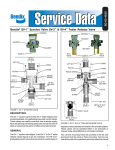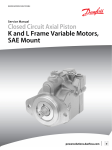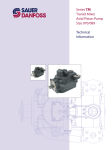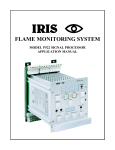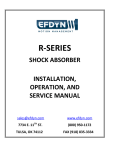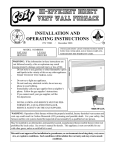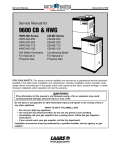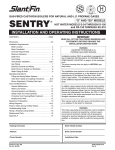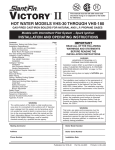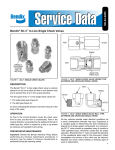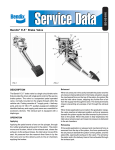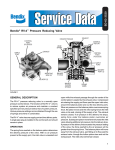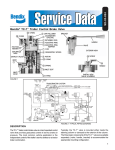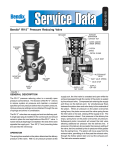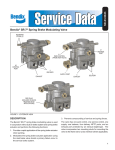Download BENDIX BW2539 User's Manual
Transcript
SD-03-4010 Bendix® SS-1™ Shut-Off Valve CONTROL PORT CONTROL PORT CAP NUT 1/4" P.T. CONTROL PORT CAP NUT O-RING PISTON PISTON RETURN SPRING PISTON O-RING VENT PORT VENT PLUG WITH 1/8" P.T. VENT DELIVERY PORT MOUNTING HOLES SUPPLY PORT SUPPLY PORT CAP NUT PISTON O-RING 1/4" P.T. DELIVERY PORT MOUNTING HOLE INLET VALVE CAP NUT O-RING INLET VALVE SPRING 1/4" P.T. SUPPLY PORT FIGURE 1- SS-1™ SHUT-OFF VALVE DESCRIPTION The SS-1™ shut-off valve (figure 1) is a pilot operated, air controlled, on-off, non-graduating, non-exhausting pneumatic control valve. The valve is primarily used to delay, sequence, or control airflow from various devices in the air brake system. It can be operated either in a pilot or automatic mode using different air connection methods. The SS-1™ valve is a general purpose valve used in a variety of applications on trucks, buses, tractors, trailers and converter dollies. It is offered in a variety of pressure settings to accommodate applications where automatic operation is required. The most common application of the SS-1™ valve is in the tractor protection system of a truck tractor. Important Note: The SS-1 ™ shut-off valve is application specific due to its pressure settings. It is therefore important to use the proper part number when replacement is required. IN ADDITION: The SS-1™ shut-off valve and SV-1™ synchro valves are identical in appearance and similar in operation but have substantial internal differences and must not be confused or used interchangeably. The SV-1™ synchro valve incorporates an internal exhaust passage through its piston, which allows delivery pressure to be vented to atmosphere while the SS-1™ does not. Refer to Service Data Sheet, SD-03-4020, for more information on the SV-1™ synchro valve. Service Data Sheets can be obtained by calling 1-800-AIR-BRAKE or by visiting www.bendix.com on the Internet. Two .28 inch mounting holes are provided in the die cast zinc body for panel or frame mounting. Two steel hex cap nuts at the ends of the cylindrical valve body retain the internal components. All air connection ports contain pipe threads. Lettering embossed in the valve body identifies two of the four ports in the valve. Refer to the chart below and figure 1. Air Connection Supply Delivery Control Vent Body Ident. SUP DEL NONE NONE Thread Size 1/4” P.T. 1/4” P.T. 1/4” P.T. 1/8” P.T. IMPORTANT: A vented, socket head vent plug is installed in some SS-1™ valves, however, an exhaust check valve should be installed in the threaded vent port when the SS-1™ valve is mounted outside the cab in unprotected environments. See Figure 2. 1/8" PIPE THREAD Note: Either style may be installed in the SS-1™ valve FIGURE 2 - EXHAUST CHECK VALVE STYLES 1 OPERATION CONTROL VALVE GENERAL Because the SS-1™ shut-off valve is a general purpose valve, it can be connected in the air system in a variety of ways to accomplish its intended function. Figure 3 displays only three of the many different connection methods that can be used. In general, the SS-1™ valve can either be connected in the system to function as a pilot operated, remote mounted, on-off valve or it can be connected in a manner that allows the valve to operate automatically at preset pressures as system pressure increases or decreases. Figure 3 displays examples of air system connections. Two examples of connections that result in pilot operation are shown and one that illustrates automatic operation. It should be noted that since the SS-1™ valve is a pressure sensitive valve, under certain air system conditions it might temporarily operate in an automatic fashion even in a system where its intended function is that of a pilot on-off valve. Regardless of how the SS-1™ shut-off valve is connected, the internal valve operation is the same. CON SUP RESERVOIR RESERVOIR Pilot Operation TRACTOR PROTECTION CONTROL VALVE CON SS-1™ VALVE When sufficient air pressure is applied to the control port, the control piston moves against the resistance of its return spring. As the control piston moves, it contacts the valve and continued piston movement drives the inlet valve from its seat and allows supply air to flow through the body and out the delivery port. When air pressure is removed from the control port, the piston return spring moves the piston away from the inlet valve. As the piston moves, the inlet valve re-seats itself preventing airflow to the delivery port. If air pressure at the supply port remains constant (is not reduced) then delivery port pressure remains equal to supply port pressure provided that devices connected to it do not dissipate delivery port pressure. If supply port pressure is removed (after control pressure is removed), then delivery port air pressure will hold the inlet valve away from its seat against the force of the inlet valve return spring. Air present at the delivery port will flow through the valve body in the reverse direction, from the delivery port, past the inlet valve, and into the supply port. Flow will continue until the delivery port pressure (which acts upon the area of the inlet valve) is reduced and equal to the force exerted by the inlet valve spring. When delivery port pressure and spring force are equal, the inlet valve re-seats in the body and air pressure remaining in the delivery line is “trapped” between the closed inlet valve and air devices connected to the delivery port. The amount of 2 DEL SUP BRAKE VALVE DOUBLE CHECK VALVE HOSE COUPLING "GLAD HAND" Pilot Operation - Tractor Protection Application PILOT (controlled remotely by another valve) With no air pressure present at the control port, supply port air pressure, if present, along with the inlet valve spring hold the inlet valve on its seat in the body. The piston is held away from the inlet valve by the piston return spring. DEL SS-1™ VALVE CON SS-1™ VALVE RESERVOIR DEL SUP Automatic Operation - Common Control & Supply FIGURE 3 TRACTOR PROTECTION SYSTEM air pressure “trapped” is dependant upon the specific part number of the valve. Valves used in a tractor protection system application will “trap” less than 5 psi while other SS-1™ valves will “trap” approximately 10 psi. AUTOMATIC (self actuating at a preset pressure) Automatic operation of the SS-1™ shut-off valve occurs when the pressure at the supply and control port is the same. This is referred to as “common control and supply” and can be accomplished by connecting the valve’s control port to its supply port using a pipe or tubing tee. With common control and supply pressure, the valve opens (delivers air) on ascending air pressure and closes on descending pressure. The pressures at which delivery and closure occur differ for various part numbers. Opening and closing pressures are specified for the various part numbers. It should be noted that as supply and control pressure descends delivery pressure will also decrease but will not be completely removed. Refer to the “Pilot” operation in this section. Important: Consult Bendix® cataloging and/or Bendix® Engineering for specific opening and closing control pressures when the SS-1™ valve is used in the automatic mode. When using the SS-1™ shut-off valve in this manner, the control signal ramp rate should be limited by orificing or other methods. Please contact Bendix® Engineering with specific application requirements. PREVENTIVE MAINTENANCE Important: Review the Bendix® Warranty Policy before performing any intrusive maintenance procedures. The warranty may be voided if intrusive maintenance is performed during the warranty period. No two vehicles operate under identical conditions, as a result, maintenance intervals may vary. Experience is a valuable guide in determining the best maintenance interval for air brake system components. At a minimum, the SS-1™ valve should be inspected every 6 months or 1500 operating hours, whichever comes first, for proper operation. Should the SS-1 ™ valve not meet the elements of the operational tests noted in this document, further investigation and service of the system or valve may be required. If the SS-1™ valve fails to function as described or leakage is excessive, it should be replaced with a genuine Bendix® service unit of the same part number, available at Bendix® authorized parts outlets. WARNING! PLEASE READ AND FOLLOW THESE INSTRUCTIONS TO AVOID PERSONAL INJURY OR DEATH: When working on or around a vehicle, the following general precautions should be observed at all times. Always wear safety glasses. 1. Park the vehicle on a level surface, apply the parking brakes, and always block the wheels. 2. Stop the engine and remove ignition key when working under or around the vehicle. When working in the engine compartment, the engine should be shut off and the ignition key should be removed. Where circumstances require that the engine be in operation, EXTREME CAUTION should be used to prevent personal injury resulting from contact with moving, rotating, leaking, heated or electrically charged components. 3. Do not attempt to install, remove, disassemble or assemble a component until you have read and thoroughly understand the recommended procedures. Use only the proper tools and observe all precautions pertaining to use of those tools. 4. If the work is being performed on the vehicle’s air brake system, or any auxiliary pressurized air systems, make certain to drain the air pressure from all reservoirs before beginning ANY work on the vehicle. If the vehicle is equipped with an AD-lS® air dryer system or a dryer reservoir module, be sure to drain the purge reservoir. 5. Following the vehicle manufacturer’s recommended procedures, deactivate the electrical system in a manner that safely removes all electrical power from the vehicle. 6. Never exceed manufacturer ’s recommended pressures. 7. Never connect or disconnect a hose or line containing pressure; it may whip. Never remove a component or plug unless you are certain all system pressure has been depleted. 8. Use only genuine Bendix ® replacement parts, components and kits. Replacement hardware, tubing, hose, fittings, etc. must be of equivalent size, type and strength as original equipment and be designed specifically for such applications and systems. 9. Components with stripped threads or damaged parts should be replaced rather than repaired. Do not attempt repairs requiring machining or welding unless specifically stated and approved by the vehicle and component manufacturer. 10. Prior to returning the vehicle to service, make certain all components and systems are restored to their proper operating condition. 11. For vehicles with Antilock Traction Control (ATC), the ATC function must be disabled (ATC indicator lamp should be ON) prior to performing any vehicle maintenance where one or more wheels on a drive axle are lifted off the ground and moving. OPERATING AND LEAKAGE TESTS OPERATING TESTS General Two accurate air gauges are necessary to perform these tests. Depending upon installation, it may be necessary to remove the valve to properly test it. When testing valves installed in an automatic application the correct opening pressures of the valve should be known before beginning tests; consult vehicle manual. Refer to figure 3 and use the appropriate Operational test. Pilot 1. Install an accurate gauge in the supply line and the other gauge in the delivery line. 2. With full system pressure present at the supply port of the SS-1™ valve, apply and release full system pressure to the control port and note that delivery pressure increases to supply port pressure with no perceptible lag. 3 3. With full system pressure present at the control port, remove all pressure from the supply port. Note that delivery port pressure is reduced to 10psi or less. Important Note: Depending upon part number and valve application on the vehicle, delivery port pressure may be required to be reduced to less than 5psi. When used in tractor protection systems, delivery pressure is generally required to be less than 5psi in this test. Consult the vehicle manual for specifications. 2. Apply 120 psi to the supply port only. Apply soap solution to the exhaust port. Leakage must not exceed a 1" bubble in less than 5 seconds (100 sccm). Excessive leakage would indicate a faulty inlet valve or inlet valve seat. If the SS-1™ valve does not function as described or if leakage is excessive, it is recommended that it be replaced with a new unit available from authorized genuine Bendix® parts outlets. Automatic REMOVING AND INSTALLING 1. Install an accurate gauge in the common control and supply line; install another gauge in the delivery line. REMOVING 2. Gradually increase air pressure to the common supply and control line. Note when pressure is first registered on the delivery line gauge and record the common control and supply pressure at that point. Compare the recorded pressure with specifications in vehicle manual or for the valve part number being tested. The recorded pressure should be plus or minus 7psi of the specified pressure. 3. Apply full system pressure to the common control and supply and note that delivery pressure increases to supply port pressure with no perceptible lag. 4. Remove all pressure from the common control and supply. Note that delivery port pressure is reduced to 10psi or less. Important Note: Depending upon part number and valve application on the vehicle, delivery port pressure may be required to be reduced to less than 5psi. LEAKAGE TESTS - ALL TYPES 1. With 120 psi air pressure present in supply, control and delivery ports: Apply a soap solution around control port cap nut and supply port cap nut. No leakage is permitted. 1. Read the Warning Section previously presented in this manual and make certain to block and hold vehicle by means other than air brakes. 2. Drain the air brake system completely. 3. Clean the exterior of the SS-1™ shut-off valve, as well as the fittings and air lines attached to the valve. 4. Identify the air lines to facilitate reinstallation, disconnect the lines, remove and retain the mounting bolts, and then the valve. 5. Remove the exhaust check from the vent port if the shut-off valve was so equipped. INSTALLING 1. Mount the SS-1™ valve securely using the mounting hardware retained during removal. 2. Using the identification made during removal, connect the air lines to the SS-1™ valve. 3. Install the exhaust check valve if the SS-1™ shut-off valve was so equipped. 4. Perform tests as outlined in the "Operating and Leakage Tests" section before placing the vehicle back into service. Apply soap solution to the exhaust port; leakage must not exceed a 1" bubble in less than 5 seconds (100 sccm). Excessive leakage would indicate faulty piston o-rings. 4 BW2539 © 2006 Bendix Commercial Vehicle Systems LLC. All rights reserved. 1/2006 Printed in U.S.A.





